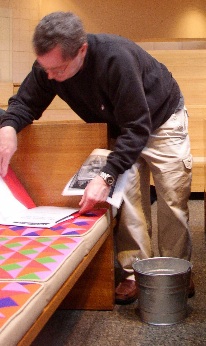A BUCKET OF STONES


A BUCKET OF STONES


THE MUSIC:
After being asked to write a piece for the Gregg Smith Singers,
I decided to write a piece about the story of the woman taken in
adultery (John 8:1-12),. The St. Matthew Passion of Heinrich Schutz
first came to mind. Like much of my own music, Schutz’s Passion
is in monody, and my original thought was to do the same. But as it
turned out, except for the SATB ending, much of this piece is in two
parts, like other recent works of mine (The Child in the Hole and
Christ and His Bride: a Lover’s Quarrel for Flute and Viola). But
I have preserved the Schutz influence by opening with the same two
pitches his Passion opens with, as well as (hopefully) a similar clarity.
Just as I was about to start working on this piece, a friend of mine
(who we used to visit in prison and now drives an 18-wheeler) told
me about a sermon he had heard by a preacher named Andy Bryan,
in which he dropped stones in a bucket while telling the story of the
woman taken in adultery. This has become the central feature in this
work as well, a visceral representation of condemnation.
But I wasn’t satisfied with the music I was composing. Then
Charles Austin, the interim pastor of the Lutheran church in Paramus
I’ve been in all my life, shared the following anecdote in a sermon:
“A reporter once asked Karl Barth if he could summarize what he
had said in his lengthy Church Dogmatics. Barth thought for a
moment and then said: ‘ Jesus loves me, this I know, for the Bible
tells me so.’" So I tried that familiar melody as the melodic basis for
this piece, and (with some work) felt satisfied with the result, both
in music and in meaning.
A Bucket of Stones may be done as a straight choral work, or, as
in its premiere performance, acted out.
THE MEANING:
The story of the woman taken in adultery is the story of sin (i.e. doing something wrong) and how
that sin it is to be dealt with. The woman in the story has sinned. So has a man, who isn’t mentioned.
So have the pharisees,out of touch with their own sins, until Jesus reminds them. According to the
Bible (Romans 3:23) “all have sinned and come short of the glory of God.”
In this current world we seek either to deny that sin exists or to hurt and even kill others that we call
sinners. We may not feel comfortable using the word “sin” nowadays, but yet we see other people doing
things wrong, and, much harder to admit, we see ourselves doing things wrong as well. We’ve all been
in both places. Stones have been thrown at us. We throw stones at others. Putting another person down
doesn’t put us any higher.
So Jesus offers a different approach, the approach of love. He sees the woman more than the sin,
the “who” more than the “do”. Throwing stones at the woman won’t remove the sin, it just removes
the sinner. He doesn’t excuse the sin either, because that’s the root cause of what’s hurting the woman.
Only forgiveness removes the sin, and saves the person. Jesus doesn’t seek to end a life, but to save
a life, even at the price of his own life.
But Jesus went to the Mount of Olives. And at dawn
he came again to the temple, and all the people came to
him, and he sat down and taught them. And the scribes
and the pharisees brought to him a woman caught in
adultery, and standing her in the middle, they said to
him, “Teacher, this woman has been caught in the act
of committing adultery. And in the Law, Moses com-
manded this kind to be stoned. You then, what do you
say?” But this they said to test him, to get to accuse him. But stooping down, Jesus wrote with his finger in
the dirt. So when they continued to ask him, he raised
himself up and said to them, “Let the one of you that’s
without sin throw the first stone at her.” And stooping
down again, he wrote in the dirt. And hearing this,
being convicted by conscience, they left one by one,
beginning with the older ones, until the last. And Jesus
was left alone, and the woman standing in the middle.
And raising himself up, and seeing nobody but the
woman, Jesus said to her, “Woman, where are they?
Has no one condemned you?” And she said, “No one,
Lord.” And Jesus said, “Neither do I condemn you.
Go and sin no longer.” Then Jesus spoke to them again
saying, “I am the light of the world. Whoever follows
me by no means shall walk in darkness, but will have
the light of life.” --JOHN 8:1-12
performed by The Gregg Smith Singers, Dale Jergenson, conductor
Pharisees: Lawrence Rush & Rhys Ritter, Jesus: Walter Richardson,
The Woman: Susan Altabet, Stone thrower: William Vollinger


The composer with bucket, preparing for
rehearsal at St. Peter’s Lutheran Church, New York City, March 16, 2007
detail from Rembrandt’s “Christ and the Woman Taken in Adultery” (1644)
music by William Vollinger
